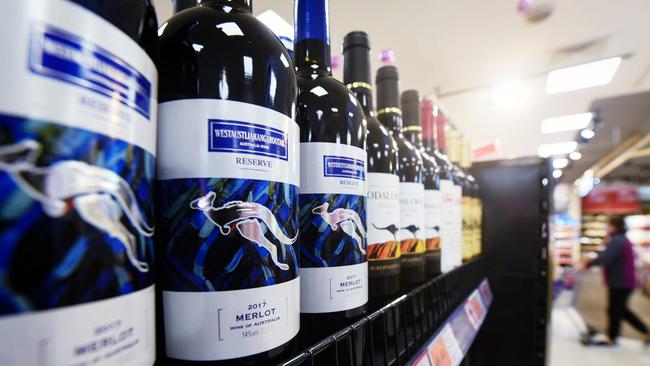Wine exports to China have all but ceased with producers not holding out for a resolution
The feared destruction of the Chinese wine export market has come to pass, with new figures showing crushing tariffs have done their job.

The Chinese wine export market has been all but destroyed, with exports in the first four months since crushing tariffs were applied falling 96 per cent to just $12m, the latest figures from Wine Australia show.
This compares with $325m in the same period to the end of March in 2020, and implies a more than $1bn hit on an annual basis to the nation’s winemakers, should other export markets not be found for the product.
In the year to September last year, before China introduced tariffs on bottled Australian wine of up to 200 per cent, wine exports to China increased 4 per cent to $1.17bn.
New Wine Australia figures released on Thursday show total Australian wine exports declined by 4 per cent in value to $2.77bn in the 12 months to March 2021, compared with the previous corresponding period.
READ MORE:Australian Vintage looking at massive profit uplift | Shock and ore – is this the last China windfall
The drop was driven principally by the Chinese tariffs, as well as the cumulative effects of three consecutive lower vintages in Australia leading to less volume available to export.
“Notwithstanding the impact of China’s tariffs, we were still looking at a potential downturn in exports over this period simply due to the supply situation,” Wine Australia chief executive Andreas Clark said.

Mr Clark said exports to China for the December 2020 to March 2021 period were just $12m, compared to $325m in the comparable period a year ago.
“As the tariffs apply to product in bottles under 2 litres, the decline in exports to China was mainly in bottled exports,’’ Mr Clark said.
“This, along with increased unpackaged shipments to other markets such as the UK, resulted in a drop in the share of bottled exports in the export mix, from 46 per cent of total volume in the 12 months ended March 2020 to 41 per cent in the same period in 2021.
“This led to the decline in the overall average value of exports.’’
Export volume declined by 1 per cent to 724 million litres (80 million 9 litre case equivalents) while the average price per litre for wine exports declined by 3 per cent to $3.82.
On the upside there was significant growth in exports to Europe, including the UK, which was up 23 per cent to $710m, the highest value in a decade.
“There was also growth to North America, up 5 per cent to $628m, and Oceania, up 7 per cent to $112m,’’ Mr Clark said.
Mr Clark said if exports to mainland China were excluded for the past 12 months, there had been positive growth in export value with a 10 per cent growth to $1.9bn and 8 per cent in volume to 646 million litres (71.8 million cases).
The Chinese government announced in November it would introduce tariffs of up to 212 per cent on Australian bottled wine following an “anti-dumping’’ inquiry.
While Australian winemakers ridiculed the notion that they could “dump” wine into the Chinese market and undercut cheap, low-quality local produce, there has been no diplomatic progress made on the broader trade war with China, which has affected other industries such as barley and coal.

The provisional wine tariff measures were initially intended to stay in place until at least August 2021 however last month they were extended for another five years.
Australian Grape and Wine chief executive Tony Battaglene said producers were not holding out hope of a resolution and were instead focusing on other markets.
“People understand that China is not likely to improve any time in the next few years,’’ Mr Battaglene said.
“Five years is what the tariffs are on for, they could go away at any time but you’d have to be living under a rock to think that relationships were such to give the incentive to do that so companies are just moving to other markets.
“The growth in the UK has been really impressive, probably helped by COVID-19 and off-premise where we’re very strong.
“People are just concentrating on other markets. “With China, we’ll be back there one day but I don’t see it in the next four to five years.’’
Mr Battaglene said the federal government had announced $70m or so in industry assistance in December, with $40m going to Austrade for market diversification.
“There’s about $18m that can go directly to industries and we’ll be looking to access some of that.’’
Mr Battaglene said he was not advocating for more assistance in the federal budget.
“We think there’s probably a fair bit of money on the table, if we spend it wisely, to help that diversification piece.
“And we need to do some longer term market access work. Markets like India down the track … part of it will be planning for that.’’
Jared Stringer, chief executive of The Lane Vineyard and president of the Adelaide Hills Wine Region, said winemakers had accepted the new reality and, given ongoing tensions between Australia and China there was no expectation of a speedy resolution.
Mr Stringer said the state government, through the Department for Trade and Investment, had moved swiftly to put programs in place to help companies develop new markets, which had been a great support.
“There’s a focus on the US. We’re looking to build on what we can in the UK, and certainly parts of South East Asia, Singapore, Vietnam and also looking into South Korea and Japan.’’
Mr Stringer said while the UK, traditionally a strong market for Australian wine, had been under severe lockdowns for much of the past year, as we move into the European summer that was scheduled to ease, presenting an opportunity for more sales in that market.
“I think there will be a bit of a momentum shift in the UK. There are some really good green shoots in some overseas markets,’’ he said, while saying it would be naive to think that the more than $1bn previously bought by China could easily be absorbed by other markets.
Mr Stringer said the 2021 vintage was shaping up to be the best in 20-30 years so the Adelaide Hills companies were very excited about the wines which will be produced this year.




To join the conversation, please log in. Don't have an account? Register
Join the conversation, you are commenting as Logout